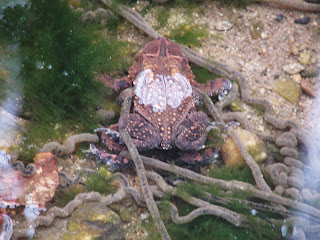Even though most amphibians in our area spend most of their lives hopping around on the forest floor, almost all reproduce in the water. At different points throughout the spring and summer, different species will find a suitable body of water and do their thing. Most species want a vernal pond that will have water long enough for the tadpoles to grow up, but that dries up later in the year. That keeps their breeding grounds from becoming a buffet for tadpole-loving fish. (Species that lay their eggs later in the year may seek out more permanent spots.)
There are lots of vernal ponds in our area -- in just about every park we go to regularly, in fact. And most of them have tadpoles in them by now. The only problem is, it's really hard to tell what species of tadpole you're looking at, except by timing and by looking at the eggs the tadpoles hatched from. (Or, we're told, you can look at their mouth parts. Which is apparently even harder than it sounds.) If you pick a pond and keep coming back, though, you may start to get a sense of who's who.
Wood frogs are one of the first species to lay their eggs -- we found some on March 10 this year. They lay their jelly-filled eggs in big spherical clumps -- each female can lay up to 2,000 eggs. They're often attached to a thin stick or other vegetation in the water. The eggs take a couple of weeks to hatch, so the tadpoles are already out and about in the water. In fact, we stopped by a pond along the Northwest Branch last week that was teeming with thousands of them -- this video captures just a small fraction of the action:
Leopard frogs come later in the spring, followed by pickerel frogs. As far as I can tell, they lay similar globs of eggs; if you really want to try to identify what you're looking at you can try these descriptions.
Around June, green frogs and bullfrogs will lay their eggs in flatter, broader masses - more like a huge pancake (up to a foot in diameter for green frogs, and 2 feet for bullfrogs) floating on or near the surface of the water. The theory goes that those black embryos at the center of each egg are capturing heat from the sun, which is insulated by all the jelly in the egg mass. It's more helpful to have ball-shaped egg masses earlier in the spring for the insulation -- the temperature of the egg mass can be significantly warmer than the water temperature. But by June it's more helpful to have all the eggs exposed to the warm air.
Instead of laying their eggs in masses, toads lay eggs in long tubes. Really long -- a strand of several thousand eggs can stretch 20 to 60 feet. A couple of weeks ago we saw American toads mating in a little inlet off the Pinehurst Branch in Rock Creek Park; their tadpoles may have hatched by now. Other toad species will lay their eggs later in the summer.
Depending on the species, eggs can take from under a week up to almost 3 weeks to hatch. Tadpoles generally take 2-3 months to get their legs and switch over to breathing air rather than water. But some species, especially bullfrogs, may overwinter as tadpoles. So, while the next couple months are prime tadpole-viewing season, there are tadpoles to look for year-round!
What's your favorite spot to look for tadpoles? Leave us a comment below!
In the wild: You can get some help in looking for tadpoles if you listen for frogs and toads -- let their calls guide you to their breeding grounds. Some of our favorite spots include:
- Two ponds on the right hand side of the Rachel Carson Trail that runs along the Northwest Branch. (This is where we took the video above.) Start from Burnt Mills Dam across from the Trader Joes on Colesville Road.
- The Pinehurst Branch trail in Rock Creek Park -- we often find tadpoles in puddles along the edge of the stream, and have found the toads we mentioned above two years in a row now.
- Huntley Meadows and Jug Bay have great wetlands that are sure to be full of amphibians at this time of year. The catch is, they're so big, the tadpoles have plenty of room to hide.
